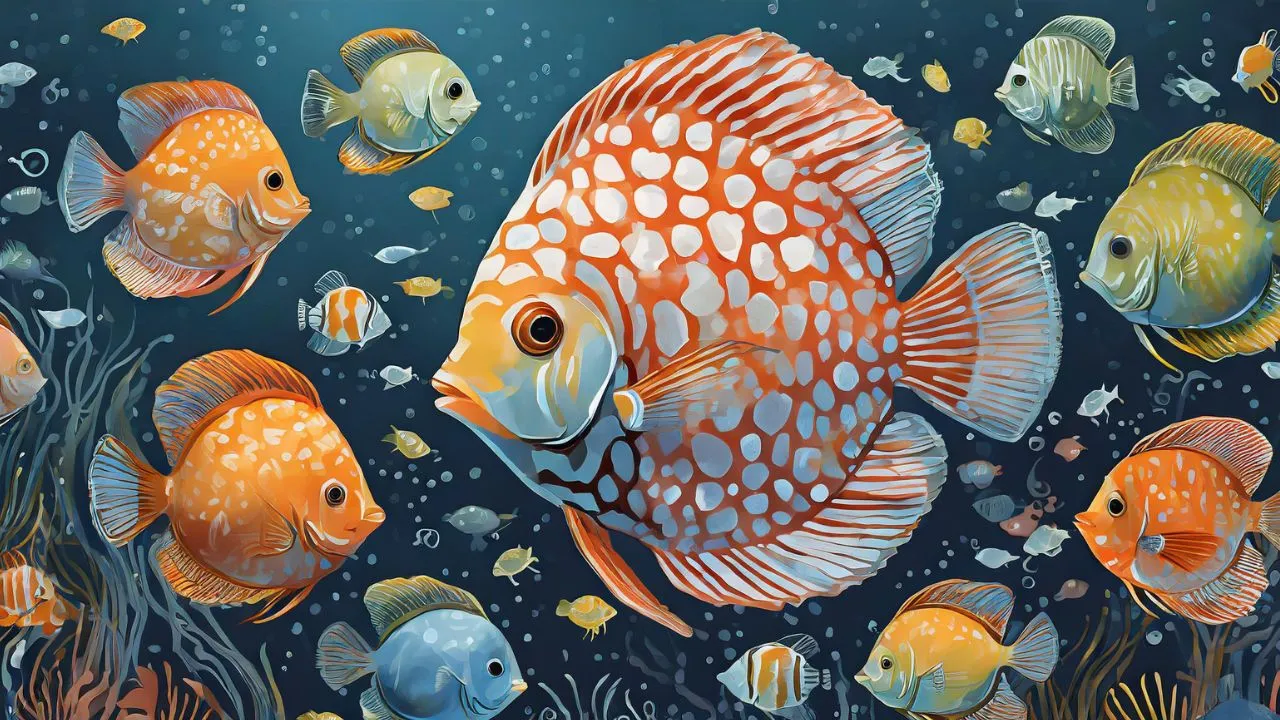Angelfish and discus are two of the most popular and beautiful freshwater fish kept by aquarium hobbyists. With their vibrant colors, elegant fins and striking appearances, it’s no wonder why many want to combine these two species in a single tank.
But can discus live with angelfish? Or will they fight and become aggressive tankmates? In this beginner’s guide, we’ll explore whether can discus live with angelfish? or can discus live in a community tank?. We’ll find out what kind of fish can discus live with, compare their care needs, temperaments, tank requirements and more to determine if they make suitable discus tank mates.
By the end, you’ll have a clear understanding of how to house angelfish with discus successfully. Let’s dive in!
Comparing the Natural Habitats of Angelfish and Discus
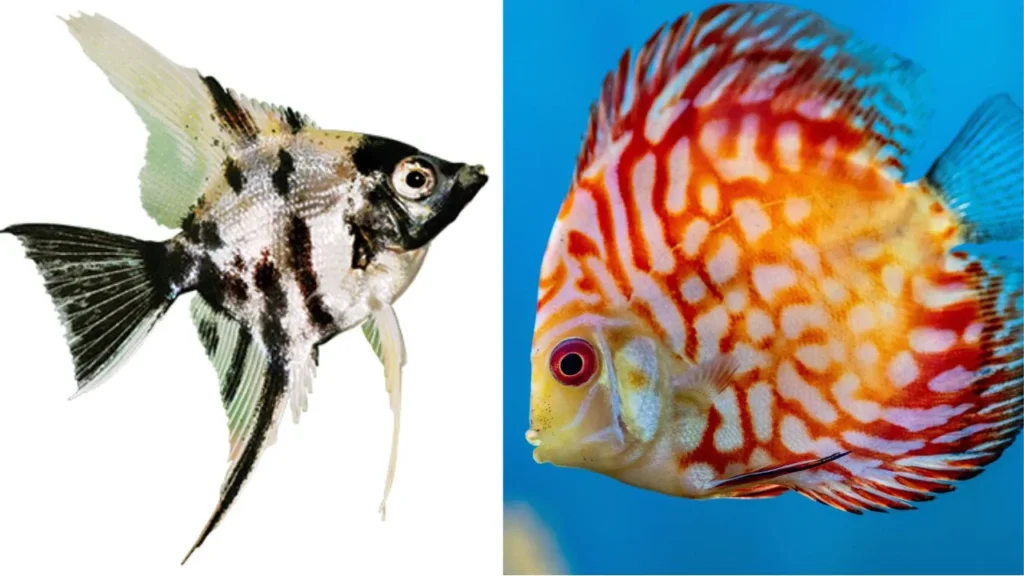
To understand whether two fish species can live together, it helps to first look at their natural environments and origins.
Angelfish are native to the Amazon River basin in South America. They inhabit slow-moving streams, smaller tributaries and flooded forests. Angelfish spend time near submerged branches and vegetation.
Discus also originate from the Amazon region. They prefer very warm, acidic and soft waters. Discus primarily live in pools and calmer areas away from fast currents. They shelter near submerged driftwood and roots.
As you can see, angelfish and discus come from similar tropical environments in South America. Both species frequent warmer, gently flowing waters that are acidic and soft in nature. This is a good indication they may thrive under similar aquarium conditions.
Comparing Water Parameter Of Angelfish With Discus
Let’s take a closer look at the comparison table of water parameter of angelfish with discus:
| WATER PARAMETER | ANGELFISH | DISCUS |
| Temperature | 76-84°F (24-29°C) | 82-90°F (28-32°C) |
| pH | 6.5-7.5 | 5.5-7.0 |
| Hardness | 4-20 dGH | 1-8 dGH |
There is some overlap in the ideal water parameters for angelfish and discus. Both prefer soft, acidic water on the warmer side. Discus do need slightly warmer temperatures and a lower pH than angelfish.
With some compromising, the water can be maintained at levels suitable for both fish. Aim for a temperature around 82-84°F and a pH between 6.0-6.5 to accommodate the needs of angelfish and discus living together.
Tank Size Requirements for Housing Angelfish With Discus
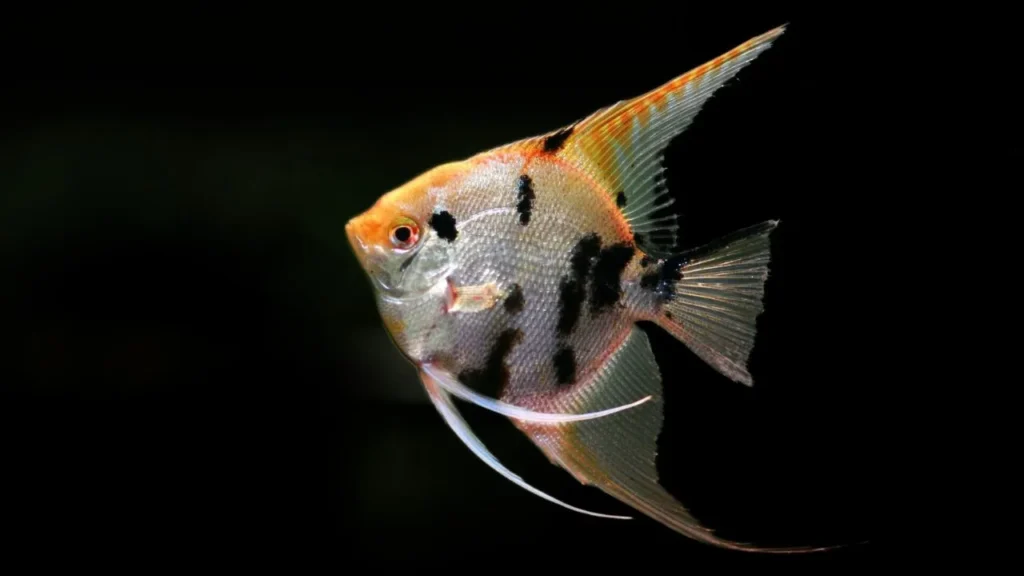
Tank size is another important factor when mixing fish species. Overcrowding causes stress, aggression and poor water conditions. So what size tank do you need for angelfish and discus?
Angelfish require a minimum of a 20 gallon tank. A 29-55 gallon aquarium is ideal for a small group or pair. Discus, on the other hand, need much larger tanks. Aim for at least 40 gallons for a single discus. For a small school, provide 75-90+ gallons.
To comfortably house angelfish with discus, a tank size of at least 55 gallons is recommended. A 75-90 gallon tank is ideal to provide ample swimming space and territory for both species. The bigger the tank, the better for reducing territorial disputes.
Comparing Discus and Angelfish Temperaments
Now let’s examine the temperaments and behaviors of angelfish and discus fish:
| TRAITS | ANGELFISH | DISCUS |
| Aggression Level | Semi-Aggressive | Peaceful |
| Territorial | Yes | No |
| Activity Level | Moderately Active | Sedentary |
| Schooling Behavior | No | Yes |
Angelfish are described as semi-aggressive fish that are territorial, especially when spawning. They have a moderate activity level and don’t school.
On the flip side, discus are very peaceful, calm fish that like to stay in groups and school together. They are not aggressive or territorial towards other fish.
The temperamental differences between angelfish and discus are fairly pronounced. Angelfish are much more likely to bully docile discus, especially if space is limited.
Also Read:
Strategies for Housing Angelfish With Discus.
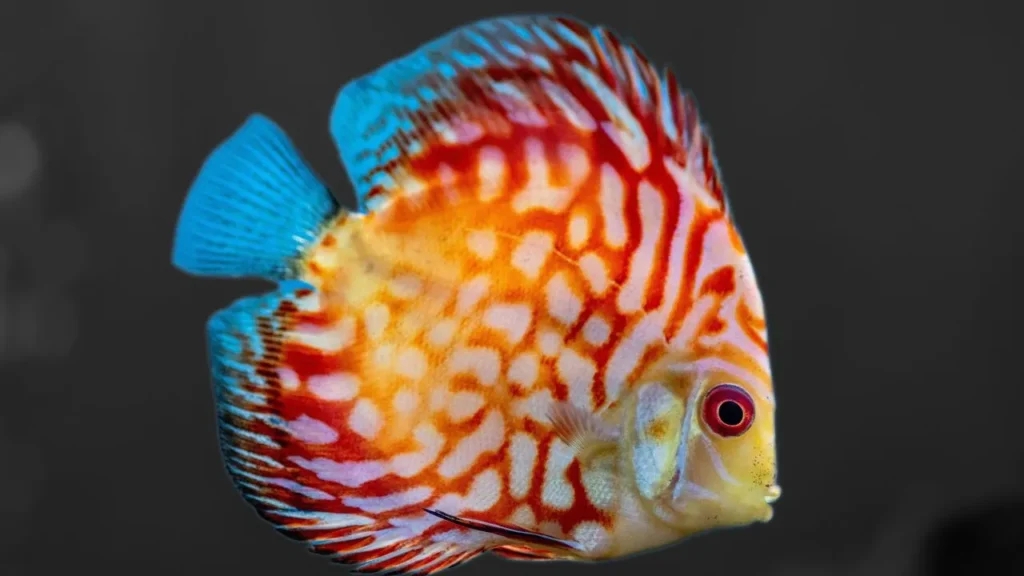
Although their temperaments differ, angelfish and discus can potentially coexist in the same tank. It requires extra planning and steps to reduce aggression. Here are some tips:
- Get Young Fish – Introduce both species as juveniles so they grow accustomed to tankmates. Adult angelfish are more aggressive.
- Add Discus First – Let the shy discus establish territory first before adding angelfish.
- Generously Plant the Tank – Live plants act as barriers and create line of sight breaks. They also provide security for discus.
- Use Driftwood & Rocks – Territory markers to prevent angelfish from monopolizing the whole tank.
- Leave Open Swimming Space – Angelfish swim at mid-level while discus use the bottom. Separate their domains.
- Offer Many Hiding Places – So discus have refuge if chased or nipped by angelfish. Caves and decor help.
- Feed Separately – Use feeding rings to isolate fish during meals. This prevents food aggression.
- Use a Large Tank – Aim for 75-90+ gallon aquariums or larger. More room dilutes territorial behavior.
- Maintain Proper Groups – Keep angelfish in pairs or trios. Have groups of 5-6 discus minimum to reduce bullying.
- Monitor Behavior – Watch for aggression or stress. Be prepared to remove problem fish if needed.
By following these guidelines, you can mitigate potential issues between angelfish and discus tankmates. Combine this with proper tank maintenance, and they can live happily together.
Also Read:
Angelfish And Discus Tank Mates.
Part of cultivating a thriving community tank is choosing suitable angelfish and discus tank mates. Some fish get along better with angelfish and discus than others.
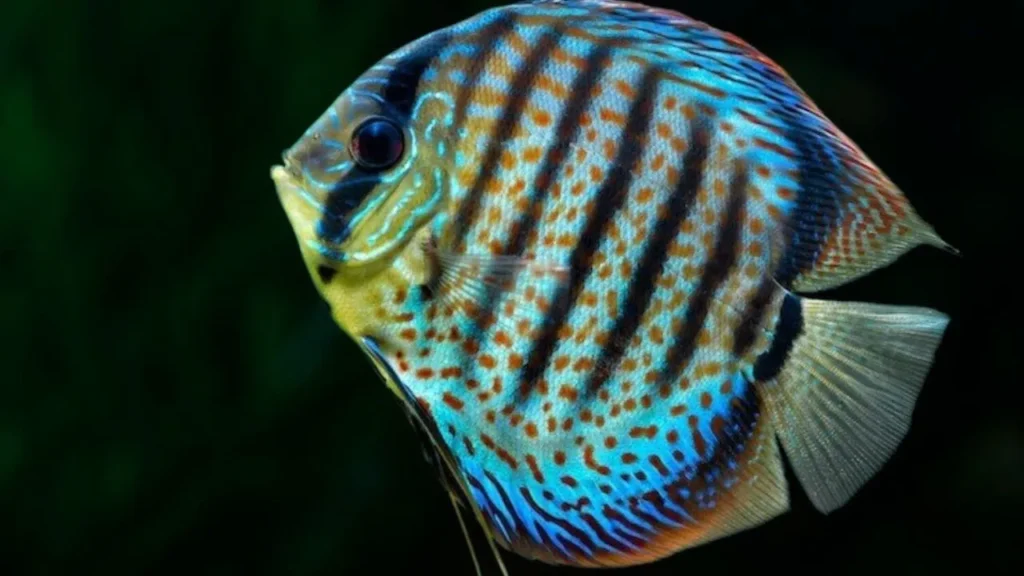
Some Ideal Candidates for Angelfish and Discus Tank Mates:
- Tetras – Larger tetras like cardinal or rummy nose tetra make great tankmates. They enjoy the same water and won’t nip fins.
- Plecos – Bristlenose and clown plecos are excellent algae-eating bottom dwellers that coexist well.
- Corydoras – Catfish like Corydoras panda and Corydoras aeneus work well. They have armored bodies and occupy the lower region.
- Otocinclus – These small, peaceful algae eaters are perfect cleanup crew members for planted discus aquariums.
- Gouramis – Select docile dwarf gouramis or honey gouramis. Avoid bigger or aggressive varieties that may bully discus.
Also Read: 15 Best Angelfish Tank Mates..
Some Species to Avoid as Angelfish and Discus Tank Mates:
- Large and messy fish – Common plecos, silver dollars, oscars.
- Fin nippers – Tiger barbs, serpae tetras, buenos aires tetras.
- Bottom dwellers – Loaches and plecos that compete for space.
- Cichlids – Convicts, firemouths, jack dempseys and others far too aggressive.
Stick to smaller, community-friendly species that share water preferences for best results. Never mix angelfish or discus with intimidating tankmates.
Feeding Angelfish and Discus in a Community Tank
Catering to the nutritional needs of multiple fish species is important. Both angelfish and discus are omnivores that accept a varied diet.
Feed them 2-3 times daily a mixture of:
- High-quality flake and pellet foods
- Frozen foods like brine shrimp, blood worms and daphnia
- Occasional live foods such as black worms and mosquito larvae
- Blanched vegetables
- Use sinking wafers and pellets. Both fish will forage as the food drifts downwards. Flakes work too but some will get wasted.
- Target feed angelfish at the middle and top levels. They are more aggressive and will readily eat first.
- Feed discus at the bottom with sinking pellets or use a feeding ring. This prevents the angelfish from stealing their food.
- Offer plenty of food. This lessens competition and allows more timid discus to eat.
- Introduce foods slowly to undiscriminating discus. They may ignore unfamiliar items at first while angelfish gobble them up.
- Give angelfish time to eat before targeting food exclusively for the discus. The angelfish fill up first reducing their food drive.
- Use driftwood, rocks or decor to place food behind. Discus will find it while angelfish are blocked.
With patience, you can ensure both discus and angelfish receive proper nutrition in a shared habitat. Catering to their individual feeding behaviors reduces competition.
Breeding Angelfish and Discus in the Same Tank
While some advanced aquarists breed angelfish and discus species together, it can be quite difficult to achieve in a community setting. Angelfish and discus have different optimal parameters for spawning. Discus prefer warmer, acidic water in the low 80s F. Angelfish breed in slightly cooler, more alkaline water around 75-79°F.
The requirements don’t overlap enough for both to breed simultaneously in a shared tank. One species would suffer suboptimal conditions. Additionally, angelfish turn very aggressive while spawning. They are likely to terrorize discus in a breeding frenzy. Discus also need pristine parameters when raising fry that cannot be guaranteed in a mixed community.
For these reasons, it’s not advisable for beginners to attempt breeding angelfish and discus together. Advanced aquarists may try with extra tanks for isolating pairs and fry when needed. Realistically, breeding should be done in separate species-only tanks to increase success rates and offspring survival. Don’t attempt breeding in a community setting until you have experience.
Caring for Angelfish and Discus Together

If you want to combine angelfish with discus, daily care and tank maintenance become extremely important for their health and wellbeing:
- Maintain warm water temperatures between 82-84°F. Use heaters designed for larger tanks.
- Perform partial water changes of 30-40% weekly, or more often. Discus produce lots of waste. Use a gravel vacuum.
- Test water parameters frequently. Shoot for 0 ammonia and nitrites with low nitrates. pH around 6.5-7.0.
- Filter the water vigorously. Canister filters are great for large tanks. Aim for at least 4x turnover rate per hour.
- Use an air stone or powerheads to increase oxygenation. Both species require well-oxygenated water.
- Quarantine new arrivals 3-4 weeks. Prevents introducing disease into an established tank.
- Have backup tanks available. This allows separating individual fish if problems arise between tankmates.
With close monitoring and ideal habitat conditions, discus and angelfish have a chance at successfully cohabitating long-term.
Troubleshooting Angelfish and Discus Living Together
Even in optimal tank environments, issues between angelfish and discus can pop up. Here are some common problems and solution to them:
| PROBLEM | SOLUTION |
| Angelfish bullying or nipping discus | Rearrange decor to break lines of sight. Add more plants, caves and hiding spots for discus to retreat. |
| Aggression during feeding time | Use feeding rings to isolate each fish when eating. Feed angelfish first. |
| Discus appear stressed with clamped fins | Improve water conditions and temperature. Add more plants and territories. Consider removing the angelfish. |
| Disease outbreak in tank | Quarantine sick fish immediately. Improve tank maintenance. Treat fish with appropriate medications. |
| Discus not eating well | Target feed discus away from angelfish. Focus on offering live, frozen and pelleted foods. |
| Spawning behavior and increased aggression | Temporary separate discus and angelfish until breeding subsides. |
Don’t hesitate to make adjustments, move fish to hospital tanks or remove aggressive species if issues arise. Act quickly at the first signs of trouble.
Common FAQs On “Can Discus Live With Angelfish?”
Will Angelfish Kill Discus?
It’s unlikely angelfish will directly kill discus in most cases. However, angelfish may intimidate, bully or nip at discus, especially during feeding time or if breeding. Discus are quite docile and can become stressed to the point of illness or death when harassed by aggressive tankmates like angelfish. Providing plenty of space, line of sight breaks, and hiding spots can help reduce aggression.
Can I keep a single discus?
No, keeping just one discus is not recommended. Discus are social fish that prefer to live in groups of 5 or more of their own kind. A single discus will become stressed in isolation which leads to poor health and immunity. They require the security of a group to thrive.
What kind of fish can discus live with?
Good tankmates for discus include small tetras, rasboras, cory catfish, dwarf gouramis, small plecos, and other peaceful community fish that share the same water parameters. Avoid housing discus with large or aggressive species that may bully or nip their fins.
Can discus live with angelfish in the wild?
Yes, angelfish and discus occupy similar habitats in the Amazon region of South America. Wild discus tend to favor slightly warmer, softer and more acidic waters than angelfish. But they coexist in the flooded forests and tributaries of the Amazon basin.
Can discus live in a community tank?
Discus can be kept in a peaceful community tank with appropriate tankmates, provided their specific needs are met. The aquarium must be large (75+ gallons), warm (82-86°F), have pristine water quality, and include calm fish with comparable care requirements. Strict maintenance routines must be followed as well in a community discus tank.
How many angelfish and discus in a 75 gallon tank?
A good stocking for a 75 gallon tank would be either:
1 Angelfish Pair + 5 Discus OR
3 Angelfish + 5 Discus This allows for adequate territory and swimming space to reduce aggression between the two cichlid species.
What should I feed discus and angelfish to ensure their nutritional needs are met?
Feed a varied, protein-rich diet of high quality flakes, pellets, frozen foods like bloodworms and brine shrimp, along with occasional live foods. Soak dry foods before feeding. Take care to feed both species separately if needed to prevent the angelfish from hogging the food supply. Both have slightly different nutritional needs as omnivores. Variety is key.
The Bottom Line
Can discus live with angelfish? The answer is yes – with caution. These two beautiful species can coexist peacefully in a home aquarium. However, there are challenges due to their differing temperaments and care needs.
Providing a spacious tank with plenty of territory, combined with careful monitoring and maintenance, will give angelfish and discus the best chance. Select tank mates wisely, feed correctly and respond promptly to any emerging problems between the two fish.
While not ideal for beginners, mixing angelfish and discus can result in a dazzling showcase tank in the hands of an experienced aquarist. If you’re up for the challenge, go for it! But be prepared for the extra diligence required to help these two fish thrive side-by-side long term.

